lock Citroen JUMPY 2010 2.G Owner's Guide
[x] Cancel search | Manufacturer: CITROEN, Model Year: 2010, Model line: JUMPY, Model: Citroen JUMPY 2010 2.GPages: 225, PDF Size: 10.84 MB
Page 69 of 225
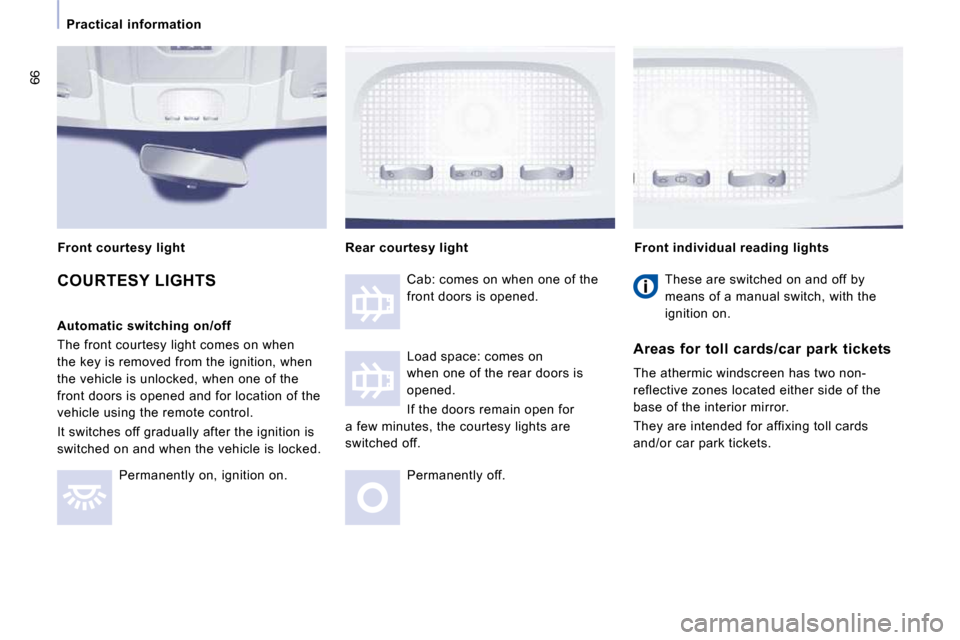
66
Practical information
COURTESY LIGHTS
Automatic switching on/off
The front courtesy light comes on when
the key is removed from the ignition, when
the vehicle is unlocked, when one of the
front doors is opened and for location of the
vehicle using the remote control.
It switches off gradually after the ignition is
switched on and when the vehicle is locked. Permanently on, ignition on. Cab: comes on when one of the
front doors is opened.
Load space: comes on
when one of the rear doors is
opened.
If the doors remain open for
a few minutes, the courtesy lights are
switched off.
Permanently off. Front individual reading lights
Rear courtesy light
These are switched on and off by
means of a manual switch, with the
ignition on.
Areas for toll cards/car park tickets
The athermic windscreen has two non-
reflective zones located either side of the
base of the interior mirror.
They are intended for affixing toll cards
and/or car park tickets.
Front courtesy light
Page 75 of 225
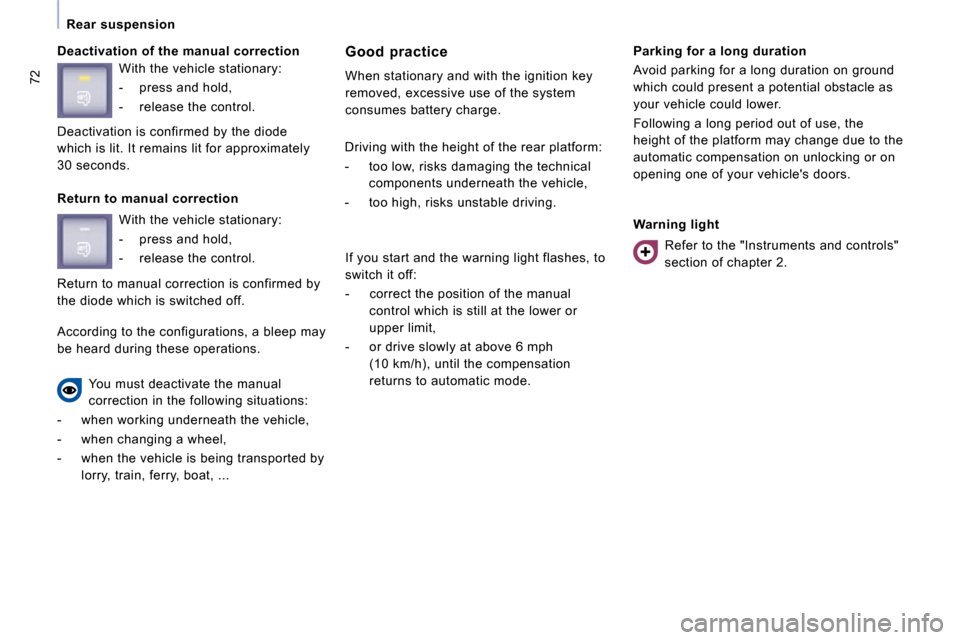
72
Rear suspension
Deactivation of the manual correction Good practice
When stationary and with the ignition key
removed, excessive use of the system
consumes battery charge. Parking for a long duration
Avoid parking for a long duration on ground
which could present a potential obstacle as
your vehicle could lower.
Following a long period out of use, the
height of the platform may change due to the
automatic compensation on unlocking or on
opening one of your vehicle's doors.
With the vehicle stationary:
- press and hold,
- release the control.
Return to manual correction
According to the configurations, a bleep may
be heard during these operations. You must deactivate the manual
correction in the following situations:
- when working underneath the vehicle,
- when changing a wheel,
- when the vehicle is being transported by lorry, train, ferry, boat, ... Warning light
Driving with the height of the rear platform:
- too low, risks damaging the technical
components underneath the vehicle,
- too high, risks unstable driving.
With the vehicle stationary:
- press and hold,
- release the control. Refer to the "Instruments and controls"
section of chapter 2.
If you start and the warning light flashes, to
switch it off:
- correct the position of the manual
control which is still at the lower or
upper limit,
- or drive slowly at above 6 mph (10 km/h), until the compensation
returns to automatic mode.
Return to manual correction is confirmed by
the diode which is switched off.
Deactivation is confirmed by the diode
which is lit. It remains lit for approximately
30 seconds.
Page 81 of 225

ABS
ABS
Driving safely
HORN
Press the centre of the steering wheel.
ANTI-LOCK BRAKING SYSTEM (ABS - EBFD)
The ABS and EBFD (electronic brake force
distribution) systems improve the stability
and manoeuvrability of your vehicle on
braking, in particular on poor or slippery
surfaces.
The ABS prevents locking of the wheels,
the EBFD provides control of the braking
pressure wheel by wheel. Good practice
The anti-lock braking system comes into
operation automatically when there is a risk
of wheel lock. It does not reduce the braking
distance.
On very slippery surfaces (ice, oil, etc...)
the ABS may increase the braking distance.
When braking in an emergency, do not
hesitate to press the brake pedal firmly,
without releasing the pressure, even on a
slippery surface, you will then be able to
continue to manoeuvre the vehicle to avoid
an obstacle.
Normal operation of the ABS may be felt by
slight vibration of the brake pedal.
When changing wheels (tyres and rims),
ensure that these are recommended by
CITROËN.
If this warning light comes on,
together with the brake and STOP
warning lights, accompanied by
an audible signal and a message
on the display, it indicates a malfunction of
the electronic brake force distribution which
could result in a loss of control of the vehicle
on braking.
Stop immediately.
EMERGENCY BRAKING ASSISTANCE SYSTEM (EBA)
In an emergency, this system enables the
optimum braking pressure to be reached
more quickly, press the pedal firmly without
releasing it.
It is triggered by the speed at which the
brake pedal is activated.
This alters the resistance of the brake pedal
under your foot.
If this warning light comes on,
accompanied by an audible signal
and a message on the display,
it indicates a malfunction of the
ABS which could result in a loss of control of
the vehicle on braking. In both cases, contact a CITROËN dealer.
To prolong the operation of the emergency
braking assistance system: keep your foot
on the brake pedal.
Page 84 of 225
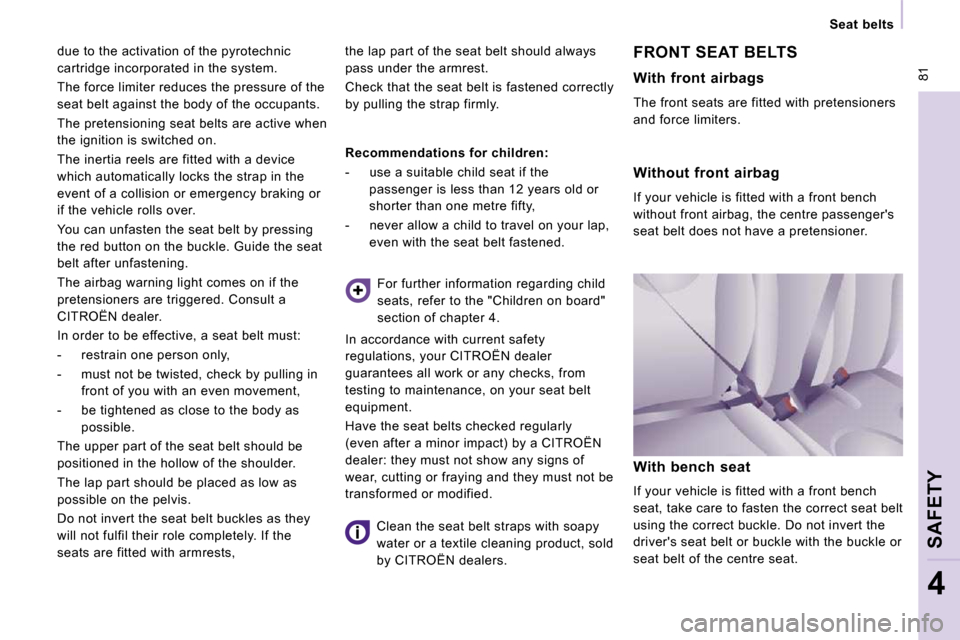
81
Seat belts
SAFETY
4
due to the activation of the pyrotechnic
cartridge incorporated in the system.
The force limiter reduces the pressure of the
seat belt against the body of the occupants.
The pretensioning seat belts are active when
the ignition is switched on.
The inertia reels are fitted with a device
which automatically locks the strap in the
event of a collision or emergency braking or
if the vehicle rolls over.
You can unfasten the seat belt by pressing
the red button on the buckle. Guide the seat
belt after unfastening.
The airbag warning light comes on if the
pretensioners are triggered. Consult a
CITROËN dealer.
In order to be effective, a seat belt must:
- restrain one person only,
- must not be twisted, check by pulling in front of you with an even movement,
- be tightened as close to the body as possible.
The upper part of the seat belt should be
positioned in the hollow of the shoulder.
The lap part should be placed as low as
possible on the pelvis.
Do not invert the seat belt buckles as they
will not fulfil their role completely. If the
seats are fitted with armrests, Recommendations for children:
- use a suitable child seat if the
passenger is less than 12 years old or
shorter than one metre fifty,
- never allow a child to travel on your lap, even with the seat belt fastened. FRONT SEAT BELTS
For further information regarding child
seats, refer to the "Children on board"
section of chapter 4.
In accordance with current safety
regulations, your CITROËN dealer
guarantees all work or any checks, from
testing to maintenance, on your seat belt
equipment.
Have the seat belts checked regularly
(even after a minor impact) by a CITROËN
dealer: they must not show any signs of
wear, cutting or fraying and they must not be
transformed or modified.
Clean the seat belt straps with soapy
water or a textile cleaning product, sold
by CITROËN dealers. With front airbags
The front seats are fitted with pretensioners
and force limiters.
Without front airbag
If your vehicle is fitted with a front bench
without front airbag, the centre passenger's
seat belt does not have a pretensioner.
With bench seat
If your vehicle is fitted with a front bench
seat, take care to fasten the correct seat belt
using the correct buckle. Do not invert the
driver's seat belt or buckle with the buckle or
seat belt of the centre seat.
the lap part of the seat belt should always
pass under the armrest.
Check that the seat belt is fastened correctly
by pulling the strap firmly.
Page 95 of 225

90
Child safety
ADVICE ON CHILD SEATS
The incorrect installation of a child seat in a
vehicle compromises the child's protection in
the event of an accident.
Remember to fasten the seat belts or the
child seat harnesses keeping the slack in
relation to the child's body to a minimum ,
even for short journeys.
For optimum installation of the "forward
facing" child seat, ensure that the back of
the child seat is in contact with the back of
the vehicle's seat and that the head restraint
does not cause any discomfort.
If the head restraint has to be removed,
ensure that it is stored or attached securely
to prevent it from being thrown around the
vehicle in the event of sharp braking.
Children under the age of 10 must not travel
in the "forward facing" position on the front
passenger seat, unless the rear seats are
already occupied by other children, cannot
be used or are absent.
Deactivate the passenger airbag when a
"rear facing" child seat is installed on the
front seat.
Otherwise, the child would risk being
seriously injured or killed if the airbag were
to inflate. As a safety precaution, do not leave:
- one or more children alone and
unsupervised in a vehicle,
- a child or an animal in a vehicle which is exposed to the sun, with the windows
closed,
- the keys within reach of children inside the vehicle.
To prevent accidental opening of the doors,
use the "Child Lock".
Take care not to open the rear windows by
more than one third.
To protect young children from the rays of
the sun, fit side blinds to the rear windows. Installing a booster seat
The chest part of the seat belt must be
positioned on the child's shoulder without
touching the neck.
Ensure that the lap part of the seat belt
passes correctly over the child's thighs.
CITROËN recommends the use of a booster
seat which has a back, fitted with a seat belt
guide at shoulder level.
Page 101 of 225
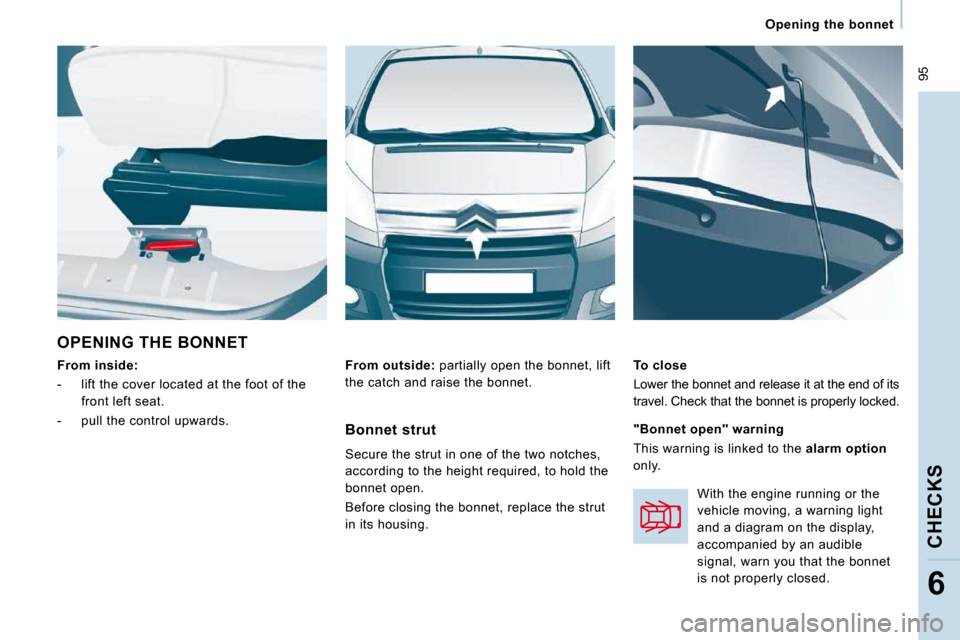
95
Opening the bonnet
CHECKS
6
OPENING THE BONNET
From inside:
- lift the cover located at the foot of the front left seat.
- pull the control upwards. To close
Lower the bonnet and release it at the end of its
travel. Check that the bonnet is properly locked.
From outside: partially open the bonnet, lift
the catch and raise the bonnet.
Bonnet strut
Secure the strut in one of the two notches,
according to the height required, to hold the
bonnet open.
Before closing the bonnet, replace the strut
in its housing. "Bonnet open" warning
This warning is linked to the
alarm option
only.
With the engine running or the
vehicle moving, a warning light
and a diagram on the display,
accompanied by an audible
signal, warn you that the bonnet
is not properly closed.
Page 102 of 225
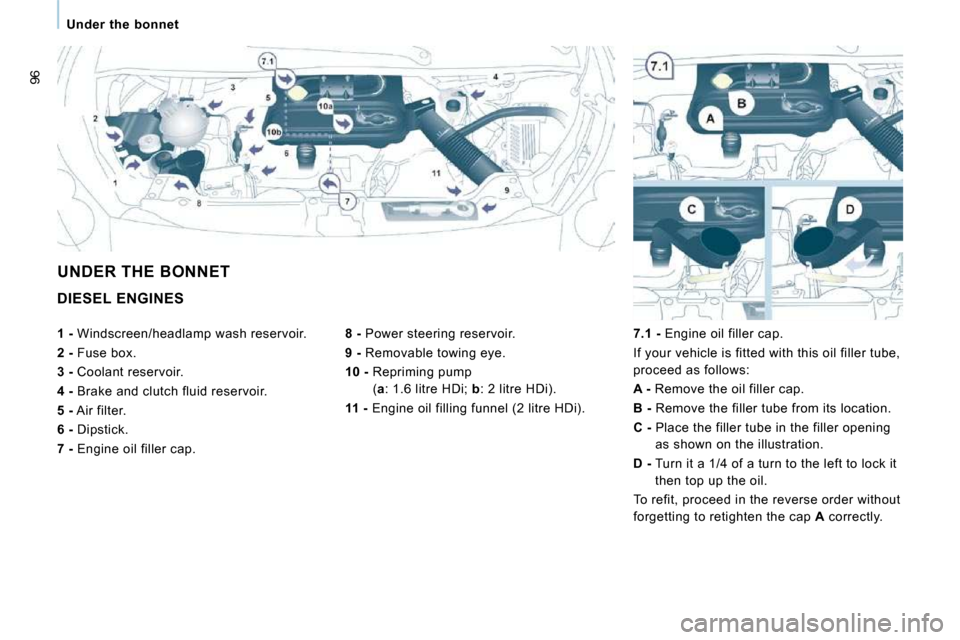
96
Under the bonnet
DIESEL ENGINES
8 - Power steering reservoir.
9 - Removable towing eye.
10 - Repriming pump
( a : 1.6 litre HDi; b : 2 litre HDi).
11 - Engine oil filling funnel (2 litre HDi).
7.1 - Engine oil filler cap.
If your vehicle is fitted with this oil filler tub e,
proceed as follows:
A - Remove the oil filler cap.
B - Remove the filler tube from its location.
C - Place the filler tube in the filler opening
as shown on the illustration.
D - Turn it a 1/4 of a turn to the left to lock it
then top up the oil.
To refit, proceed in the reverse order without
forgetting to retighten the cap A correctly.
UNDER THE BONNET
1 - Windscreen/headlamp wash reservoir.
2 - Fuse box.
3 - Coolant reservoir.
4 - Brake and clutch fluid reservoir.
5 - Air filter.
6 - Dipstick.
7 - Engine oil filler cap.
Page 108 of 225
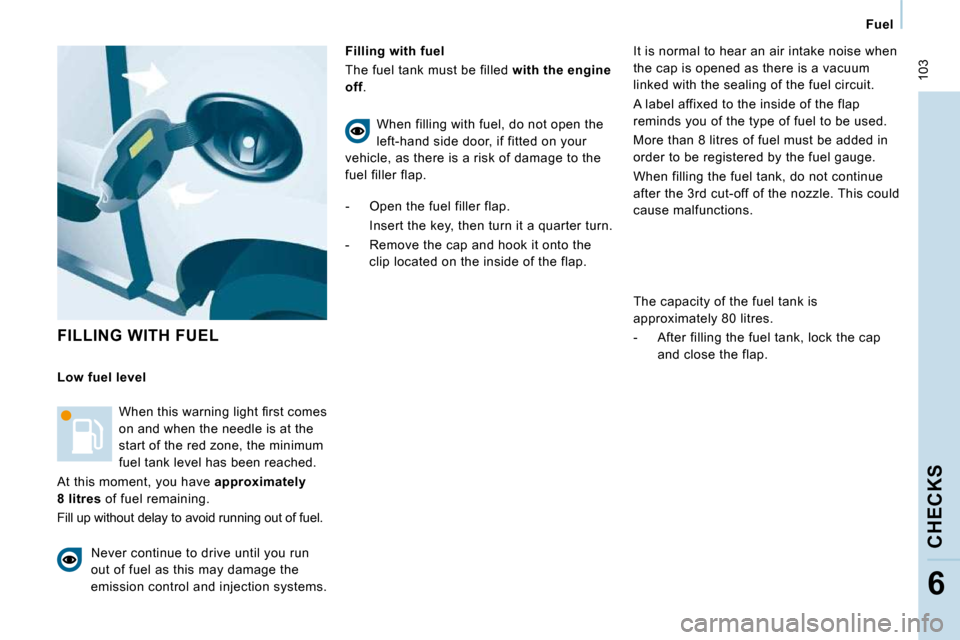
103
Fuel
CHECKS
6
FILLING WITH FUEL
Filling with fuel
The fuel tank must be filled with the engine
off .
Low fuel level � �W�h�e�n� �t�h�i�s� �w�a�r�n�i�n�g� �l�i�g�h�t� �fi� �r�s�t� �c�o�m�e�s�
on and when the needle is at the
start of the red zone, the minimum
fuel tank level has been reached.
At this moment, you have approximately
8 litres of fuel remaining.
Fill up without delay to avoid running out of fuel. When filling with fuel, do not open the
left-hand side door, if fitted on your
vehicle, as there is a risk of damage to the
fuel filler flap.
- Open the fuel filler flap.
Insert the key, then turn it a quarter turn.
- Remove the cap and hook it onto the clip located on the inside of the flap. It is normal to hear an air intake noise when
the cap is opened as there is a vacuum
linked with the sealing of the fuel circuit.
A label affixed to the inside of the flap
reminds you of the type of fuel to be used.
More than 8 litres of fuel must be added in
order to be registered by the fuel gauge.
When filling the fuel tank, do not continue
after the 3 rd cut-off of the nozzle. This could
cause malfunctions.
The capacity of the fuel tank is
approximately 80 litres.
- After filling the fuel tank, lock the cap
and close the flap.
Never continue to drive until you run
out of fuel as this may damage the
emission control and injection systems.
Page 120 of 225
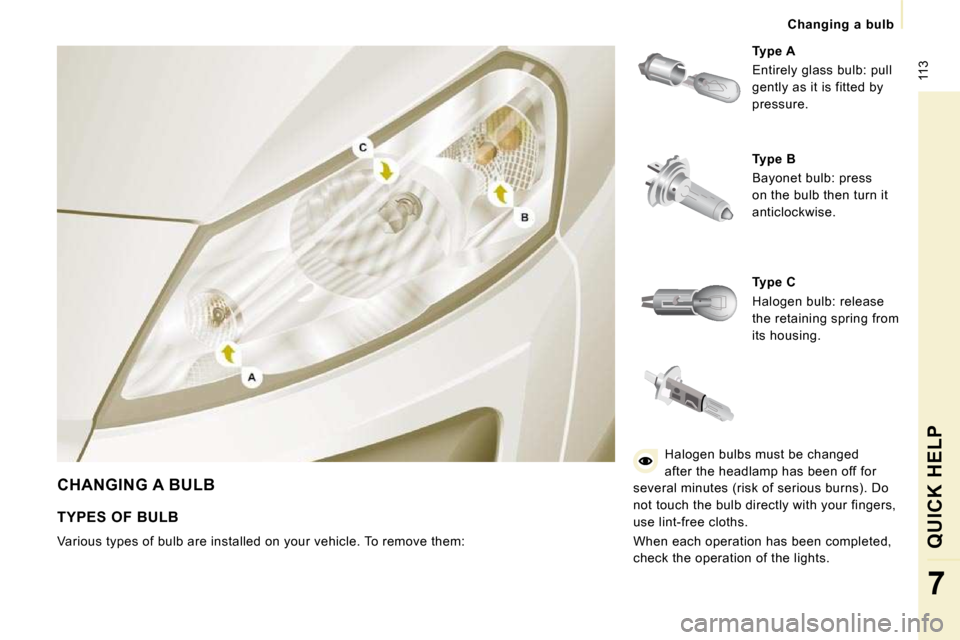
113
Changing a bulb
QUICK HELP
7
CHANGING A BULB
Type A
Entirely glass bulb: pull
gently as it is fitted by
pressure.
Type B
Bayonet bulb: press
on the bulb then turn it
anticlockwise.
Type C
Halogen bulb: release
the retaining spring from
its housing.
TYPES OF BULB
Various types of bulb are installed on your vehicl e. To remove them: Halogen bulbs must be changed
after the headlamp has been off for
several minutes (risk of serious burns). Do
not touch the bulb directly with your fingers,
use lint-free cloths.
When each operation has been completed,
check the operation of the lights.
Page 121 of 225
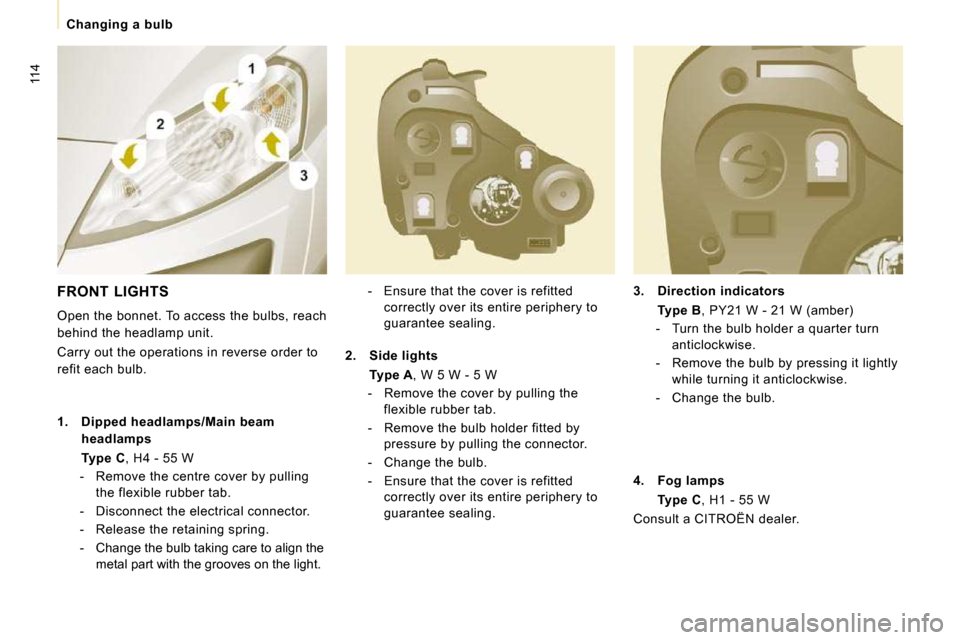
114
Changing a bulb
3. Direction indicators
Type B , PY21 W - 21 W (amber)
- Turn the bulb holder a quarter turn anticlockwise.
- Remove the bulb by pressing it lightly while turning it anticlockwise.
- Change the bulb.
- Ensure that the cover is refitted
correctly over its entire periphery to
guarantee sealing.
FRONT LIGHTS
Open the bonnet. To access the bulbs, reach
behind the headlamp unit.
Carry out the operations in reverse order to
refit each bulb.
1. Dipped headlamps/Main beam
headlamps
Type C , H4 - 55 W
- Remove the centre cover by pulling the flexible rubber tab.
- Disconnect the electrical connector.
- Release the retaining spring.
- Change the bulb taking care to align the metal part with the grooves on the light.
2. Side lights
Type A , W 5 W - 5 W
- Remove the cover by pulling the flexible rubber tab.
- Remove the bulb holder fitted by pressure by pulling the connector.
- Change the bulb.
- Ensure that the cover is refitted correctly over its entire periphery to
guarantee sealing.
4. Fog lamps
Type C , H1 - 55 W
Consult a CITROËN dealer.